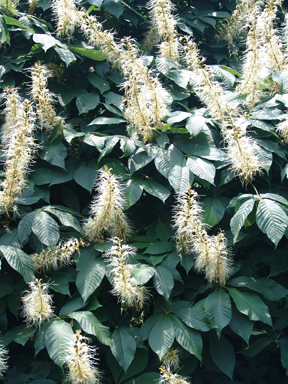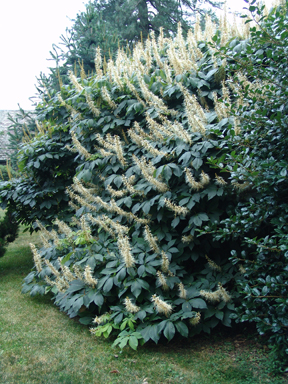Aesculus parviflora
The other week I was working with Arboretum Assistant, Steven Taub when we noticed a large planting of bottlebrush buckeye near the tennis courts. The plants had already formed long spikes of buds, which were getting ready for a spectacular show later this month. Right now the white panicles are just beginning to bloom, and they will eventually reach an impressive twelve inches in length. The tightly held spires consist of hundreds of flowers, each of which resembles a “bottlebrush,” thus the common name.
Unlike most Aesculus species, which are sizable trees, Aesculus parviflora reaches a height of around ten feet or so, and then increases in width via underground stems. The width is highly variable as the shrub is never stagnant, and will slowly colonize large areas. The broadly rounded form is a great asset for defining large spaces, while not be coming rampant.
Fall color may be an appreciable yellow, but is inconsistent. However, the palmately compound leaves are a dark green and provide a complimentary texture to the form. Foliage also creates a neat effect when young shoots emerge from the ground, creating an almost groundcover like effect.
Because of the bottlebrush’s potential size, a spot must be carefully chosen in order to compensate for the increasing width. The wild spreading habit is a positive characteristic that one should incorporate into naturalistic settings.
The bottlebrush buckeye will grow in full sun with adequate moisture and can also be grown in considerable shade. Shady locations do not impact the floral performance, but can make the overall form a bit more sporadic. It can be used for many purposes, but my favorite places are along woodland edges, as an understory shrub, or as a mass planting as it occurs at Scott. Mass plantings will eventually take on a contiguous form as individual plantings merge together. A mass planting in bloom is truly an impressive sight! This species can be difficult to locate at conventional nurseries, but is often readily available at native plant nurseries.







John Manion
Posted at 15:58h, 16 JulySam:
Nice piece! Ours in Atlanta has some of the gardens best color in autumn, and unlike S. pavia, it keeps its foliage well into fall and even through drought.